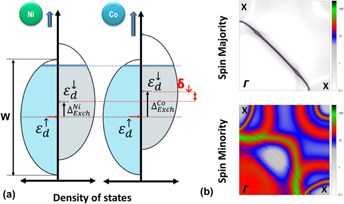Crossref Citations
This article has been cited by the following publications. This list is generated based on data provided by
Crossref.
Wang, Xing
Barr, Christopher M.
Jin, Ke
Bei, Hongbin
Hattar, Khalid
Weber, William J.
Zhang, Yanwen
and
More, Karren L.
2019.
Defect evolution in Ni and NiCoCr by in situ 2.8 MeV Au irradiation.
Journal of Nuclear Materials,
Vol. 523,
Issue. ,
p.
502.
Tong, Yang
and
Zhang, Fuxiang
2019.
Critical Review of Chemical Complexity Effect on Local Structure of Multi-principal-Element Alloys.
JOM,
Vol. 71,
Issue. 10,
p.
3419.
Ristić, Ramir
Figueroa, Ignacio A.
Lachová, Andrea
Michalik, Štefan
Mikšić Trontl, Vesna
Pervan, Petar
Zadro, Krešo
Pajić, Damir
and
Babić, Emil
2019.
Transition from high-entropy to Cu-based (TiZrNbNi)1−xCux metallic glasses.
Journal of Applied Physics,
Vol. 126,
Issue. 15,
Mu, Sai
Wimmer, S.
Mankovsky, S.
Ebert, H.
and
Stocks, G.M.
2019.
Influence of local lattice distortions on electrical transport of refractory high entropy alloys.
Scripta Materialia,
Vol. 170,
Issue. ,
p.
189.
Kudrnovský, J.
Drchal, V.
Máca, F.
Turek, I.
and
Khmelevskyi, S.
2019.
Electron transport in high-entropy alloys:
AlxCrFeCoNi
as a case study.
Physical Review B,
Vol. 100,
Issue. 1,
Sobieraj, Damian
Wróbel, Jan S.
Rygier, Tomasz
Kurzydłowski, Krzysztof J.
El Atwani, Osman
Devaraj, Arun
Martinez Saez, Enrique
and
Nguyen-Manh, Duc
2020.
Chemical short-range order in derivative Cr–Ta–Ti–V–W high entropy alloys from the first-principles thermodynamic study.
Physical Chemistry Chemical Physics,
Vol. 22,
Issue. 41,
p.
23929.
Qian, Chenhao
Qiu, Yuanhe
He, Ziyang
Mu, Weiwei
Tang, Yongmeng
Wang, Haijun
Xie, Mengmeng
Ji, Weixi
and
Zheng, Jie
2020.
Effects of interstitial carbon atoms on texture structure and mechanical properties of FeMnCoCr alloys.
PLOS ONE,
Vol. 15,
Issue. 12,
p.
e0242322.
Fedorov, Mark
Wróbel, Jan S.
Fernández-Caballero, Antonio
Kurzydłowski, Krzysztof J.
and
Nguyen-Manh, Duc
2020.
Phase stability and magnetic properties in fcc Fe-Cr-Mn-Ni alloys from first-principles modeling.
Physical Review B,
Vol. 101,
Issue. 17,
Thébaud, S.
Polanco, C. A.
Lindsay, L.
and
Berlijn, T.
2020.
Success and breakdown of the T-matrix approximation for phonon-disorder scattering.
Physical Review B,
Vol. 102,
Issue. 9,
Lei, Lei
Huang, Danlian
Cheng, Min
Deng, Rui
Chen, Sha
Chen, Yashi
and
Wang, Wenjun
2020.
Defects engineering of bimetallic Ni-based catalysts for electrochemical energy conversion.
Coordination Chemistry Reviews,
Vol. 418,
Issue. ,
p.
213372.
Vdovin, K. N.
Dubskii, G. A.
Deev, V. B.
Dolgushin, D. M.
Nefed’ev, A. A.
Egorova, L. G.
and
Prusov, E. S.
2020.
Effect of the Impulsive Magnetic Field in the Course of Crystallization of Aluminum Alloys on Their Physical Properties.
Metallurgist,
Vol. 63,
Issue. 9-10,
p.
1077.
Velişa, G.
Fan, Z.
Crespillo, M.L.
Bei, H.
Weber, W.J.
and
Zhang, Y.
2020.
Temperature effects on damage evolution in ion-irradiated NiCoCr concentrated solid-solution alloy.
Journal of Alloys and Compounds,
Vol. 832,
Issue. ,
p.
154918.
Billington, D.
James, A. D. N.
Harris-Lee, E. I.
Lagos, D. A.
O'Neill, D.
Tsuda, N.
Toyoki, K.
Kotani, Y.
Nakamura, T.
Bei, H.
Mu, S.
Samolyuk, G. D.
Stocks, G. M.
Duffy, J. A.
Taylor, J. W.
Giblin, S. R.
and
Dugdale, S. B.
2020.
Bulk and element-specific magnetism of medium-entropy and high-entropy Cantor-Wu alloys.
Physical Review B,
Vol. 102,
Issue. 17,
Yin, Danqing
Liang, Guangbing
Fan, Shuai
and
Li, Shanxin
2020.
Ultrasonic Cavitation Erosion Behavior of AlCoCrxCuFe High Entropy Alloy Coatings Synthesized by Laser Cladding.
Materials,
Vol. 13,
Issue. 18,
p.
4067.
Fan, Zhe
Tong, Yang
and
Zhang, Yanwen
2021.
High-Entropy Materials: Theory, Experiments, and Applications.
p.
645.
Liu, Liyuan
Zhang, Yang
Han, Jihong
Wang, Xiyu
Jiang, Wenqing
Liu, Chain‐Tsuan
Zhang, Zhongwu
and
Liaw, Peter K.
2021.
Nanoprecipitate‐Strengthened High‐Entropy Alloys.
Advanced Science,
Vol. 8,
Issue. 23,
Egami, Takeshi
Odbadrakh, Khorgolkhuu
and
Oh, Hyunseok
2021.
High-Entropy Materials: Theory, Experiments, and Applications.
p.
287.
Esters, Marco
Oses, Corey
Hicks, David
Mehl, Michael J.
Jahnátek, Michal
Hossain, Mohammad Delower
Maria, Jon-Paul
Brenner, Donald W.
Toher, Cormac
and
Curtarolo, Stefano
2021.
Settling the matter of the role of vibrations in the stability of high-entropy carbides.
Nature Communications,
Vol. 12,
Issue. 1,
Dong, Ya-Guang
Chen, Shang
Jia, Nan-Nan
Zhang, Qiu-Hong
Wang, Liang
Xue, Yun-Fei
and
Jin, Ke
2021.
Microstructures and mechanical properties of Ta–Nb–Zr–Ti–Al refractory high entropy alloys with varying Ta/Ti ratios.
Tungsten,
Vol. 3,
Issue. 4,
p.
406.
Liu, Xianglin
Zhang, Jiaxin
Yin, Junqi
Bi, Sirui
Eisenbach, Markus
and
Wang, Yang
2021.
Monte Carlo simulation of order-disorder transition in refractory high entropy alloys: A data-driven approach.
Computational Materials Science,
Vol. 187,
Issue. ,
p.
110135.
